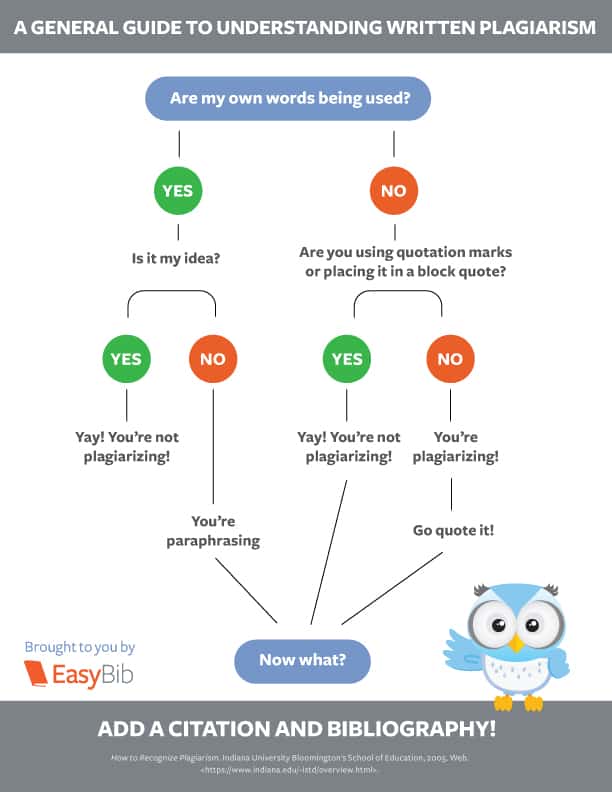Am I Plagiarizing?

Source: EasyBib
Why Cite Your Sources?
When you write a research paper, you use information and facts from a variety of resources to support your own ideas or to help you develop new ones. Books, articles, caselaw, videos, interviews, and Web sites are some examples of sources you might use. Citing these sources of information in your work is essential because:
* It gives credit to the author of the original work who provided you with the information or idea
* It allows your audience to identify and find the source material in order to learn more about your topic
* It gives your paper more credibility because it shows you're supporting your arguments with high-quality sources.
Learn more about trademarks, copyrights, and patents
How To Avoid Plagiarism?
The entire section below came from a research guide from Butler University Libraries. To avoid plagiarism, one must provide a reference to that source to indicate where the original information came from (see the "Source:" section below).
READ THE SOURCE IN ITS ENTIRETY
- It's easy to take something out of context if you only read a portion of it! If you read the entire source, you should have a better feel of the author's meaning.
TAKE DETAILED NOTES AS YOU READ
- Anytime you note something word-for-word, immediately place it in quotation marks. Also note what page or section you found it on.
- On each page, make sure you note the original source and the date you accessed the source. This will make citation much easier, especially if you are working with multiple sources or doing research over a long stretch of time.
- Try not to mix your own thoughts and commentary with excerpts from your source. Keep them on separate pages, draw two columns on your page, or switch your pen color.
- If you find it difficult to take notes with electronic sources - or if you find yourself drawn to the copy-paste method - print out your sources and deal with them in print form.
RETURN TO YOUR NOTES LATER
- In order to do this, you must not procrastinate on your projects. If you don't have sufficient time, you won't do your best work, and it may lead you to make poor decisions when including your sources. Remember, if you get caught plagiarizing, the situation or your intentions won't be an excuse. Build in time to synthesize and properly work in your sources.
- Identify which sources are best for inclusion. Understand when you have to cite. Then decide whether you should directly quote, summarize, or paraphrase. If you are directly quoting, double-check your notes against the source for accuracy. If you are summarizing or paraphrasing:
- Make sure the source is fresh in your mind, but not right in front of you. If you see the original text, you are more likely to want to use their terms and sentence structure.
- Check your writing against the original. Remember, you should have changed the sentence structure and the language but the meaning of the source should still be the same. Any language that is unique to the source should be placed in quotation marks or removed. You may find it necessary to do several edits.
CONSULT WITH THE EXPERTS
- If you need a second opinion, ask! Ask a librarian, a classmate, the Writing Center, or your professor.
Source: Avoiding Plagiarism: How to Avoid Plagiarism. Butler University Libraries.
Quoting
When quoting directly, put quotation marks around the exact words you are quoting and keep the person’s name near the quote (remember not to overuse direct quotes as they might decrease the effectiveness of your work). If the quotation is longer than forty words, write it as an indented separate paragraph and give in-text reference.
When quoting indirectly (paraphrasing or summarising), begin with a statement giving credit to the source (e.g. According to…,) and rewrite the key ideas using different words and sentence structures than the original text.
Tips:
1. When paraphrasing or summarising, read the text carefully then rewrite it in your own words. Then check to make sure you haven’t used the same words or phrases. It is important that the information in the original text be recorded correctly.
2. A combination of direct and indirect quoting is also very common. Make the differentiation clear by using quotation marks for direct quotes.
Source: Plagiarism Handout. METU Academic Writing Center
Translate This Page
METU Library Citing Sources
-
APA and MLA Writing Formats by
ISBN: 0205424376Publication Date: 2003-12-03 -
Cite Right by
ISBN: 9780226484631Publication Date: 2011-05-15 -
Writing Research Papers byISBN: 0321078829Publication Date: 2000-01-01
-
The Plagiarism Plague by
ISBN: 1555705014Publication Date: 2004-01-01 -
Cite Them Right by
ISBN: 9781137273116Publication Date: 2013-05-10 -
MLA Handbook for Writers of Research Papers by
ISBN: 9781603290258Publication Date: 2009-01-01 -
Mastering APA Style by
ISBN: 1557988919Publication Date: 2001-11-01 -
Academic Writing and Plagiarism by
ISBN: 9780826491664Publication Date: 2008-09-24 -
The Complete Guide to Referencing and Avoiding Plagarism by
ISBN: 9780335220892Publication Date: 2007-07-01